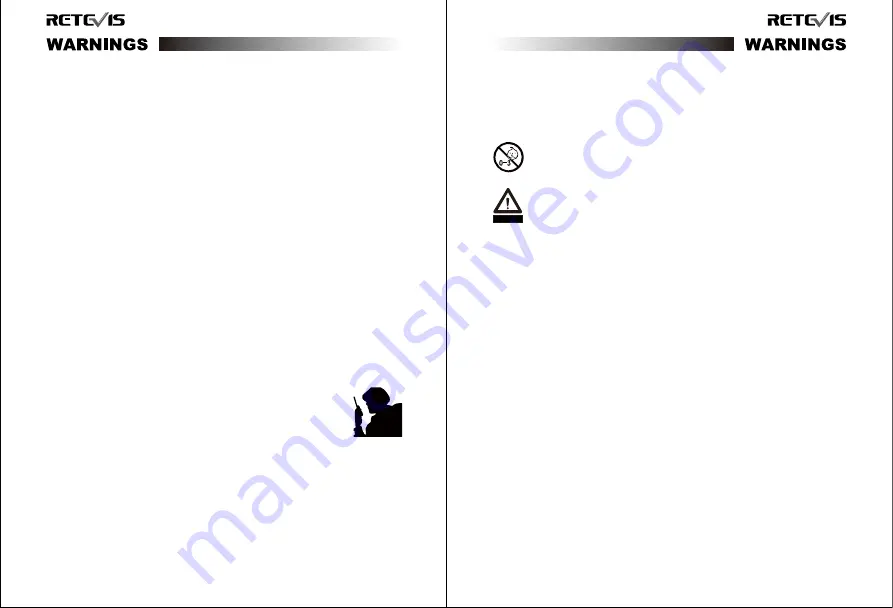
energy exposure only when transmitting in terms of measuring for
standards compliance.
•Transmit only when people outside the vehicle are at least the
recommended minimum lateral distance away from a properly
installed according to installation instructions, externally mounted
antenna.
•When operating in front of the face, worn on the body, always
place the radio in a Retevis approved clip, holder, holster, case, or
body harness for this product. Using approved body-worn
accessories is important because the use of Non-Retevis approved
accessories may result in exposure levels, which exceed the
IEEE/ICNIRP occupational/controlled environment RF exposure
limits.
•If you are not using a body worn accessory and are not using the
radio in the intended use position, in front of the face or at the body
in the PTT mode or alongside of the head in the phone mode, then
ensure the antenna and the radio are kept 2.5 cm (one inch) from
the body when transmitting. Keeping the radio at a proper distance
is important because RF exposures decrease with increasing
distance from the antenna
Hand-held Mode
• Hold the radio in a vertical position with the microphone
(and other parts of the radio including the antenna) at
least 2.5 cm (one inch) away from the nose or lips. The
antenna should be kept away from the eyes. Keeping the radio at a
proper distance is important as RF exposure decreases with
increasing distance from the antenna.
Phone Mode
•When placing or receiving a phone call, hold your radio product as
you would a wireless telephone. Speak directly into the microphone.
Electromagnetic Interference/Compatibility
NOTE: Nearly every electronic device is susceptible to
electromagnetic interference (EMI) if inadequately shielded,
designed, or otherwise configured for electromagnetic compatibility.
WARNING
Avoid Choking Hazard
Small Parts. Not for children under 3 years.
Turn off your radio power in the following conditions:
•Turn off your radio before removing (installing) a battery or
accessory or when charging battery.
•Turn off your radio when you are in a potentially hazardous
environments: Near electrical blasting caps, in a blasting
area, in explosive atmospheres (inflammable gas, dust
particles, metallic powders, grain powders, etc.).
•Turn off your radio while taking on fuel or while parked at
gasoline service stations.
To avoid electromagnetic interference and/or compatibility
conflicts
••Turn off your radio in any facility where posted notices
instruct you to do so, hospitals or health care facilities
(Pacemakers, Hearing Aids and Other Medical Devices)
may be using equipment that is sensitive to external RF
energy.
•Turn off your radio when on board an aircraft. Any use of a
radio must be in accordance with applicable regulations per
airline crew instructions.
Note:
Pacemakers
Defibrillators or other Implanted Medical Devices Persons
with pacemakers, Implantable Cardioverter-Defibrillators
22
23


































